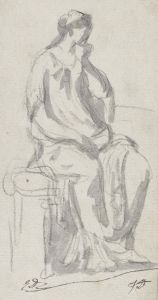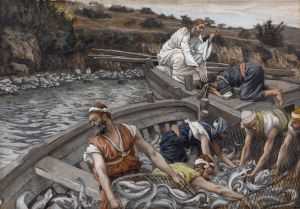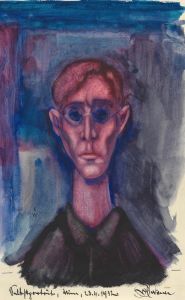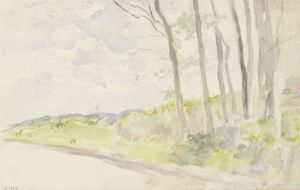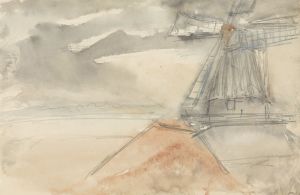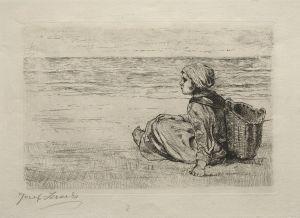
Een vrouw zit op een duin naar zee te kijken
A hand-painted replica of Jozef Israëls’s masterpiece Een vrouw zit op een duin naar zee te kijken, meticulously crafted by professional artists to capture the true essence of the original. Each piece is created with museum-quality canvas and rare mineral pigments, carefully painted by experienced artists with delicate brushstrokes and rich, layered colors to perfectly recreate the texture of the original artwork. Unlike machine-printed reproductions, this hand-painted version brings the painting to life, infused with the artist’s emotions and skill in every stroke. Whether for personal collection or home decoration, it instantly elevates the artistic atmosphere of any space.
Jozef Israëls, a prominent Dutch painter of the 19th century, is renowned for his poignant and emotive depictions of rural and maritime life. One of his notable works is "Een vrouw zit op een duin naar zee te kijken," which translates to "A Woman Sitting on a Dune Looking at the Sea." This painting exemplifies Israëls' mastery in capturing the quiet introspection and emotional depth of his subjects, a hallmark of his artistic style.
Israëls was born on January 27, 1824, in Groningen, Netherlands. He initially studied art in Amsterdam and later in Paris, where he was influenced by the Romantic movement and the works of painters such as François Millet. Upon returning to the Netherlands, Israëls became associated with the Hague School, a group of artists known for their realistic portrayals of everyday life and their use of subdued color palettes.
"Een vrouw zit op een duin naar zee te kijken" is a quintessential example of Israëls' focus on the human condition and the natural environment. The painting depicts a solitary woman seated on a sand dune, gazing out towards the sea. The composition is simple yet profound, capturing a moment of solitude and contemplation. The woman's posture and the expansive view of the sea suggest themes of longing, reflection, and the passage of time.
Israëls' use of color and light in this painting is particularly noteworthy. The muted tones and soft brushstrokes create a sense of tranquility and introspection. The sky and sea are rendered in harmonious hues, enhancing the serene atmosphere of the scene. Israëls often employed such techniques to evoke emotion and to draw the viewer into the inner world of his subjects.
Throughout his career, Israëls was celebrated for his ability to convey deep emotion and narrative through his art. His works often depicted the lives of fishermen, peasants, and other rural figures, highlighting their struggles and resilience. This focus on the common people and their connection to nature resonated with audiences and earned him widespread acclaim.
In addition to his artistic achievements, Israëls was also a significant figure in the Dutch art community. He was a member of the Pulchri Studio in The Hague and played a vital role in the development of the Hague School. His influence extended beyond the Netherlands, as his works were exhibited internationally and collected by major museums and private collectors.
"Een vrouw zit op een duin naar zee te kijken" remains an enduring example of Jozef Israëls' artistic legacy. It reflects his deep empathy for his subjects and his ability to capture the subtle nuances of human emotion. The painting continues to be appreciated for its timeless beauty and its insight into the human experience.
Israëls passed away on August 12, 1911, in The Hague, leaving behind a rich body of work that continues to inspire and move audiences. His contributions to art are remembered as a vital part of the 19th-century Dutch painting tradition, and his works remain a testament to his skill and sensitivity as an artist.





